11 Jun OSHA Issues COVID-19 Emergency Temporary Standard for Health Care
[wpseo_breadcrumb]
The ETS was developed to protect health care and health care support service workers from occupational exposure to COVID-19 in settings where people with COVID-19 are reasonably expected to be present. The ETS is expected to become effective as soon as it is published in the Federal Register.


 On June 10, 2021, the Occupational Safety and Health Administration (OSHA) announced its
On June 10, 2021, the Occupational Safety and Health Administration (OSHA) announced its  The
The  According to a Gartner poll, 86% of organizations incorporated new technology to interview job candidates due to the COVID-19 pandemic.
According to a Gartner poll, 86% of organizations incorporated new technology to interview job candidates due to the COVID-19 pandemic.